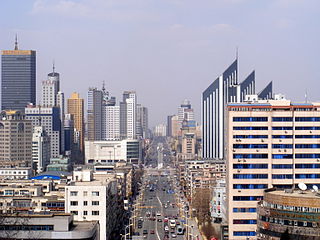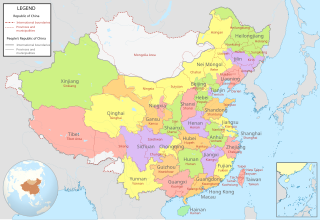Related Research Articles

Anhui is an eastern landlocked province of the People's Republic of China. Its provincial capital and largest city is Hefei. The province is located across the basins of the Yangtze River and the Huai River, bordering Jiangsu to the east, Zhejiang to the southeast, Jiangxi to the south, Hubei to the southwest, Henan to the northwest, and Shandong for a short section in the north.

Hefei is the capital and largest city of Anhui Province, People's Republic of China. A prefecture-level city, it is the political, economic, and cultural center of Anhui. Its population was 9,369,881 as of the 2020 census and its built-up area made up of four urban districts plus Feidong, Feixi and Changfeng counties being urbanized, was home to 7,754,481 inhabitants. Located in the central portion of the province, it borders Huainan to the north, Chuzhou to the northeast, Wuhu to the southeast, Tongling to the south, Anqing to the southwest and Lu'an to the west. A natural hub of communications, Hefei is situated to the north of Chao Lake and stands on a low saddle crossing the northeastern extension of the Dabie Mountains, which forms the divide between the Huai and Yangtze rivers.

Liaoning is a coastal province in Northeast China that is the smallest, southernmost, and most populous province in the region. With its capital at Shenyang, it is located on the northern shore of the Yellow Sea, and is the northernmost coastal province of the People's Republic of China.

Anshan is an inland prefecture-level city in central-southeast Liaoning province, People's Republic of China, about 92 kilometres (57 mi) south of the provincial capital Shenyang. As of the 2020 census, it was Liaoning's third most populous city with a population of 3,325,372 people, over an area of about 9,270 km2 (3,580 sq mi) spanning 133 km (83 mi) from east to the west. Its built-up area encompassing the 4 Anshan urban districts, the 4 out of 5 urban Liaoyang districts and Liaoyang county largely being conurbated, was home to 2,712,789 million inhabitants in 2020.

Ma'anshan, also colloquially written as Maanshan, is a prefecture-level city in the eastern part of Anhui province in Eastern China. An industrial city stretching across the Yangtze River, Ma'anshan borders Hefei to the west, Wuhu to the southwest, and Nanjing to the east. It is a satellite city of the Nanjing metropolitan area and is also a city in the Yangtze River Delta Economic Zone.

Haicheng is a county-level city in central Liaoning Province, People's Republic of China, located about 120 kilometres (75 mi) southwest of the provincial capital Shenyang. It is under the administration of Anshan City, the seat of which lies 36 kilometres (22 mi) to the northeast.
Champs may refer to:

Pingdingshan, also known as Eagle City, is a prefecture-level city in central Henan province, China. It had 4,904,701 inhabitants at the 2010 census whom 1,756,333 lived in the built-up area including Ye county being conurbated.
Daxing may refer to:
The Winter Offensive of 1947 in Northeast China was a series of battles initiated by the Communist forces against the Kuomintang (Nationalists) during the Chinese Civil War after World War II.
The Economist Intelligence Unit (EIU) is the research and analysis division of the Economist Group, providing forecasting and advisory services through research and analysis, such as monthly country reports, five-year country economic forecasts, country risk service reports, and industry reports. The EIU provides country, industry, and management analysis worldwide and incorporates the former Business International Corporation, a UK company acquired by its parent company in 1986. The EIU has its main offices in four cities—London, New York, Hong Kong and Dubai.
In China, a megalopolis is a designation by the government to promote the development of a group of cities through transportation and communication links.

The 12th National Games of China were held in the northeastern province of Liaoning from 31 August to 12 September 2013. Liaoning was the sixth provincial level host of the games, following Beijing, Shanghai, Guangdong, Jiangsu and Shandong. A total of 350 events in 31 sports were held at the games.

The Shanghai–Chengdu Expressway, designated as G42 and commonly referred to as the Hurong Expressway is an east–west bound expressway that connects the eastern metropolis of Shanghai to Chengdu, the capital city of Sichuan. The expressway passes through six provinces and serves major cities such as Suzhou, Wuxi, Changzhou, Nanjing, Hefei, Wuhan, and Yichang. The eastern terminus of G42 is at the Wuning Road Interchange of Shanghai Middle Ring Road. At its western terminus, the expressway intersects the East 3rd Ring Road and connects East Erxianqiao Road in Chenghua District, Chengdu. The expressway spans 1,960 km (1,220 mi) in length.

The history of the administrative divisions of China after 1949 refers to the administrative divisions under the People's Republic of China. In 1949, the communist forces initially held scattered fragments of China at the start of the Chinese Civil War. By late 1949, they controlled the majority of mainland China, forcing the Republic of China government to relocate to Taiwan.
Yanjing Beer 2018 Chinese FA Cup was the 20th edition of the Chinese FA Cup. On 29 December 2017, Yanjing Beer extended their sponsorship contract for another four years (2018–2021).
Ni Hong is a Chinese politician who is the current Minister of Housing and Urban-Rural Development, in office since June 2022.
References
- ↑ Economist Intelligence Unit Report: China’s Future is Inland
- ↑ "EIU Media Directory". Archived from the original on 2011-07-10. Retrieved 2010-11-24.
- ↑ "The rise of the 'CHAMPS' - New report maps business opportunity in China's fastest growing cities". Archived from the original on 2012-04-06. Retrieved 2010-11-24.
- ↑ Access China White Paper and CHAMPS Infograph
- ↑ Economist Intelligence Unit
- ↑ "The Sustainability of China's Housing Boom".
- ↑ China property market ‘not a bubble’, says EIU in a new report examining the sustainability of china’s housing boom